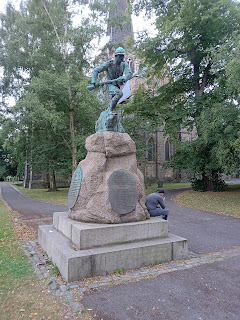AM visiting the Durham town of Darlington.
In the parish churchyard is a Boer War memorial, dedicated in 1905 by Earl Roberts, a winner of the Victoria Cross who later led the British army in South Africa, where his son died while winning a posthumous VC.
 |
| The gun's bayonet is missing - broken off sometime in the 1950s by children swinging on it |
TO THE MEMORY OF THE BRAVE MEN OF DARLINGTON WHO VOLUNTEERED
AND SERVED THE EMPIRE IN THE SOUTH AFRICAN WAR, 1899 - 1902
There are 100 names on the memorial, of whom 11 died on service.
The church is dedicated to St Cuthbert, who was born in 634 in Dunbar, which was then part of the Anglo-Saxon kingdom of Northumbria, but is now part of Scotland.
He may have been a soldier before taking monastic orders, rising to become bishop of Lindisfarne in 684, dying three years later.
He seems to have led a particularly frugal existence, enjoying the life of a hermit or traveling preacher.
There are 100 names on the memorial, of whom 11 died on service.
The church is dedicated to St Cuthbert, who was born in 634 in Dunbar, which was then part of the Anglo-Saxon kingdom of Northumbria, but is now part of Scotland.
He may have been a soldier before taking monastic orders, rising to become bishop of Lindisfarne in 684, dying three years later.
He seems to have led a particularly frugal existence, enjoying the life of a hermit or traveling preacher.
.jpg) |
| The church dates back to the early 1100s, but has been much-modified over the centuries, including by adding a spire in the 1300s |
 |
| The sundial looks a modern addition |
 |
| The chimney was a vent for Victorian boilers installed in church cellars |
.jpg)






